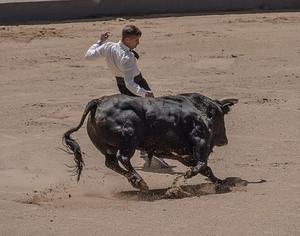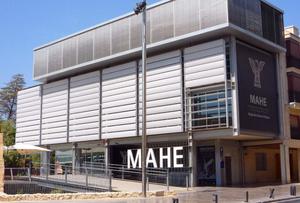Call and Book Your Hotel Now!
Domestic Toll-Free for US and Canada: 1-800-997-1438
Worldwide: +1-817-983-0682

Alicante, a city steeped in culture, is home to a diverse array of art exhibition centres and museums, both large and small. These museums have earned global renown for their collections, spanning various subjects, including archaeology, fine arts, ceramics, bullfighting, and more. Many mighty empires, including the Romans, Arabs, and Christians, have left their mark on Alicante.
These museums collectively offer a captivating journey through Alicante's rich cultural and historical heritage, inviting visitors to explore the city's multifaceted past and artistic treasures. Below, you'll find detailed information about some most prominent museums in Alicante.

Occupying the historic San Juan de Dios Hospital, this archaeological museum contains various permanent exhibitions like Prehistory, Iberian Culture, Roman Culture, Middle Ages and Modern and Contemporary Ages. These exhibition areas are linked by introductory thematic blocks. MARQ also provides rooms for temporary exhibitions, meets, etc.
Address: Plaza del Doctor Gómez Ulla, S/N 03013, Alicante, Spain.
Located adjacent to the Santa María church, this museum is a municipal museum in Alicante. MACA showcases exquisite works by local artist Eusebio Sempere, who donated their art collection to establish the museum. The collection of 20th-century contemporary art includes paintings, sculptures and mixed media. The museum consists of three permanent collections of over 800 art pieces.
Address: Plaza Santa María 3, 03002, Alicante, Spain.

The Municipal Archives, managed by the Municipal Administration, is a publicly accessible library that plays a vital role in receiving, safeguarding, and providing access to both institutional and citizen-related documents. It houses important historical documents of Alicante.
Address: Palacio Maisonnave, Calle Labradores, 03002 Alicante, Spain.
Located in a beautifully restored historic house on Calle San Augustin in Alicante, this museum showcases a diverse array of nativity scenes (Belenes), which hold immense significance in Spanish Christmas traditions. These exhibits depict various interpretations of the birth of baby Jesus. Nearly every house in Spain houses a nativity scene at Christmas time.
Address: Calle San Agustín, 3, 03002 Alicante, Spain.


The Museu Arqueològic i d'Història d'Elx (MAHE) is located in historic centre of Elche near Alicante. The museum showcases a modern perspective on the history of Elche. Through interactive displays showcasing archaeological discoveries and the historical narrative of the Muslim city of Elche, this museum provides an enriching visitor experience.
Address: Carrer de la Diagonal del Palau, 7, 03202 Elche, Alicante, Spain.

Situated within the Palacio del Conde de Lumiares, an architectural gem from the 18th century, the Museo de Bellas Artes Gravina (MUBAG) is a treasure trove of art. The museum showcases the works of renowned artists like Rodrigo de Osona, Xavier Soler, and Antonio Gisbert, among many others. This museum also holds temporary exhibitions, concerts and guided tours.
Address: Calle de Gravina, 13-15, 03002, Alicante, Spain.

The University of Alicante Museum (MUA) is a pioneering institution renowned for its innovative architecture and educational mission. Established in 1999, it bridges academia and contemporary art, hosting diverse exhibitions and workshops that promote cultural understanding and creativity among students and the wider community. The MUA also serves as a hub for academic events and artistic exploration, fostering a dynamic cultural exchange.
Address: Carr. de San Vicente del Raspeig, s/n, 03690 Sant Vicent del Raspeig, Alicante, Spain.

Dedicated to Alicante's most celebrated festival, the Hogueras de San Juan or Saint John's Bonfires, this museum displays the various stages of the festival. Visitors can explore collections of saved "ninots" (figures), bonfire models, traditional costumes, and more. The museum also has a room to watch videos about the festival.
Address: Rambla de Méndez Núñez, 29, 03002 Alicante, Spain.

This museum is located in the house where the renowned poet Miguel Hernández once resided. The 20th-century house, now a museum, offers a glimpse into the poet's family life, complete with a poultry yard, a small patio, and a collection of objects that played a significant role in Miguel's life. These objects include photographs of him with his family, furniture, and personal items. Visitors are advised to schedule a guided tour for an enriching experience.
Address: Calle Miguel Hernández, 73 03300 Orihuela, Alicante, Spain.

The Ocean Race Museum, formerly the Volvo Ocean Race Museum, tells the history of the race and showcases maritime technology advancements from 1973 to the present. With two floors, it offers exhibition space, a library, a multipurpose area for workshops, and a sea-view cafe. This interactive museum is the world's only dedicated to The Round the World Race, where you can also learn about ocean conservation and participate in The Ocean Race's efforts to protect the oceans.
Address: Mlle. Levante, 10, 03001 Alicante, Spain.

The Nueva Tabarca Museum, situated on Tabarca Island, was established in 2004 within a former tuna fishing warehouse called the Almadraba building. It explores the historical ties between coastal communities and their natural surroundings, using Tabarca Island as a prime example. The museum features two main areas: The first room offers audiovisual presentations that explore the historical interactions between humans and the marine environment. The second room houses a permanent exhibition that covers the island's geography, geology, environment, history, and ethnography. The museum also offers an interactive point where visitors can take virtual tours of Tabarca and explore images of the island's underwater environment.
Address: Partida de Tabarca, Isla, 9, 03138 Santa Pola, Alicante, Spain.